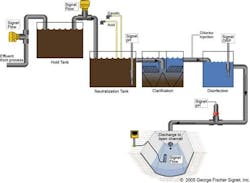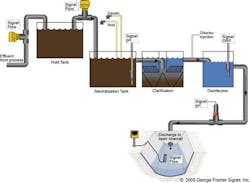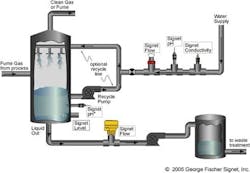Compelling reasons to choose an insertion magnetic flow sensor
While there are endless choices in fluid measurement equipment, the very nature of the processes can place limitations on the feasibility of certain technologies. For instance, in highly corrosive or dirty liquids, the use of an insertion style plastic flow sensor with moving parts can create costly damage to the entire process system if a component fails. Reversely, some highly adaptable sensors, such as full-bore devices can dramatically increase installation and replacement costs as entire sections of pipe must be cut, causing significant process downtime.
So what is the optimum choice? This article will outline why the new Signet 2551 Insertion Magmeter is recharging the fluid measurement industry with numerous compelling reasons that differentiate it as the sensor of choice.
Known as the "Paddlewheel Company," George Fischer Signet revolutionized the process industry when it introduced the first industrial Rotor-X paddlewheel flow sensor more than 40 years ago. And while the paddlewheel is still a viable, low-cost solution for many common flow measurement applications, there are instances when its inherent moving parts can impair its performance and service life, depending on the fluid conditions and other process factors.
Electromagnetic flow sensors, sometimes referred to as magmeters, work on the principle of Faraday’s Law of Electromagnetic Induction. This theory asserts that when a conductive fluid flows through a magnetic field, a voltage is produced which is proportional to the fluid’s velocity. There are no rotors or spinning turbines to wear out and no ports to get clogged by particles in the passing medium. Additionally, in the world of magmeters, there are two choices: insertion-style and full-bore, the latter mentioned earlier.
Figure 1. Diagram of internal electronics.
Insertion magnetic sensors, such as the Signet 2551 Magmeter, are slender probes placed into a fluid flow. Using microprocessor-based electronics, magmeters can reduce the cost of magnetic flow measurement by up to 40 percent compared to full bore instruments, and still deliver the same level of performance. What’s more, these insertion sensors can be installed into a wide range of pipe sizes with a compatible fitting into the line, and then inserting the sensor into the fitting by hand. You don’t even need a wrench. For instance, the Signet 2551 can be placed in pipe sizes ranging from 0.5 inch to 8 inch using the full line of Signet fittings typically used for paddlewheel sensors.
Besides the ease of installation, magmeters offer a variety of output options, either blind 4 to 20mA, frequency or digital output. The Signet 2551 Magmeter offers all three output options! The built-in microprocessor electronics deliver a stable output and can be used with Signet instruments, PLCs or chart recorders.
Highly accurate, electromagnetic flow sensors perform exceptionally well in various environments and are gaining increasing popularity in areas like China where the country is experiencing a surge of investments in infrastructure. Applications such as re-use of wastewater treatment of industrial discharge, influent water treatment for the purpose of drinking water and groundwater/mining leachate are all becoming more and more important as resources throughout the world are becoming scarce. The fluid in these applications is laden with debris, waste and other particles that can easily stop a spinning rotor (or other moving part) in its tracks.
Figure 2. Industrial Discharge.
Desalination is a process that can greatly benefit from electromagnetic technology. The purpose of desalination is to convert salt water, taken directly from the ocean, into various uses such as drinking water. Thus, the incoming salt water, containing suspended solids such as sand or fibrous particles, passes through various points of measurement including flow, pressure and conductivity. Additionally, media filtration and reverse osmosis are just a couple of the system processes included in this application.
Chemical scrubbers are the most common forms of odor control at municipal wastewater treatment plants. The process of chemical scrubbing requires the addition of large amounts of caustic and dangerous chemicals. Due to its durable, corrosion-resistant construction of Polypropolene (PP) or PVDF, the Signet 2551 Magmeter is useful for incoming and outgoing liquids.
Figure 3. Chemical Scrubbers.
The Signet 2551 features superior linearity (±1% reading, ±0.033 ft/sec.) and provides excellent performance in harsh environments. Additional features include a 2-wire system that further reduces installation costs and an integral stainless steel ground ring to ensure accurate measurement even in electrically noisy environments. Maximum quality is assured by complete factory testing and a test certificate supplied with each sensor.
George Fischer Signet, Inc., known worldwide for its fluid measurement instruments and sensors, is a division of Swiss-based Georg Fischer Corporation, a world leader in technologies and products in the fields of manufacturing, plant engineering, automotive, and the development of sophisticated, corrosion-resistant and ultra-pure piping systems and components. Their collective product offering includes plastic pipes, fittings, valves, actuators, rotameters, fusion machines, secondary containment, tank linings, heat exchangers, custom products, sensors and instrumentation for industrial process control. The synergy of both offers a complete solution for system automation, and includes an industry-leading reputation for quality, service and support.



